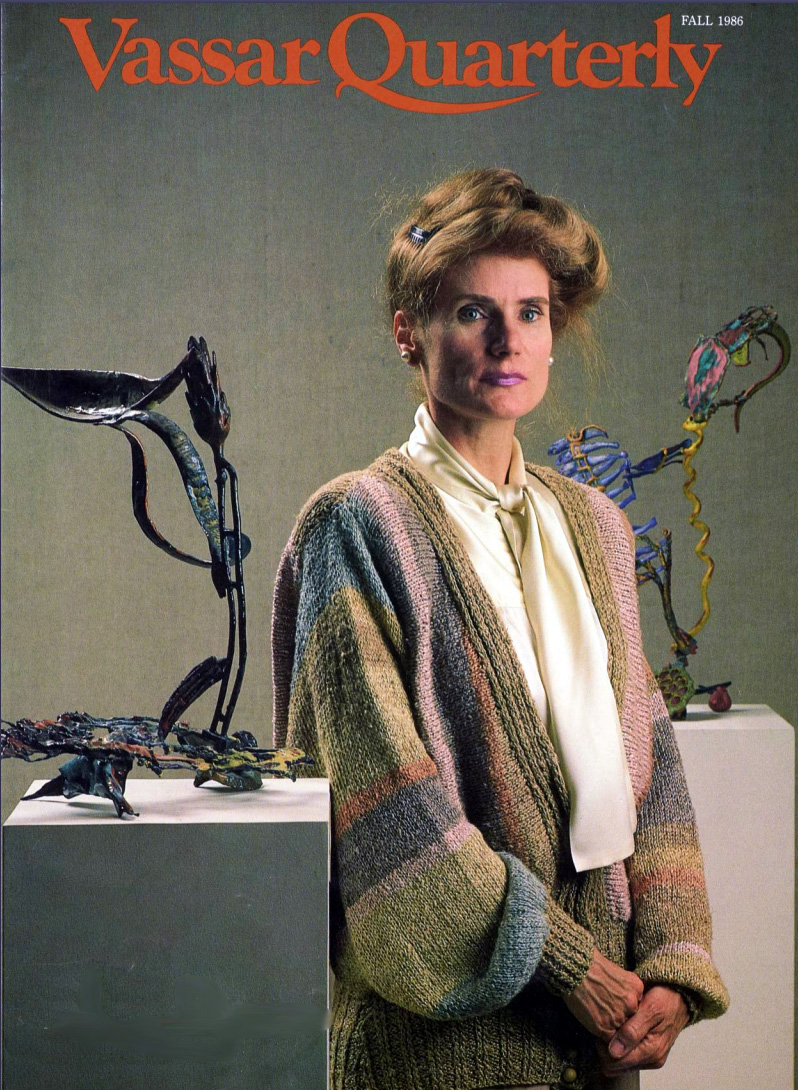Nancy Graves ’1961

One of the two daughters of Walter L. and Mary Bates Graves, Nancy Stevenson Graves’61 was born on December 23, 1939, in Pittsfield, Massachusetts. She attended Miss Hall’s School in Pittsfield and the Northfield School for Girls. Her interest in art arose early through visits to Berkshire Museum, where her father worked as assistant to the director. Founded in 1903, the museum combined natural science and cultural artifacts with both early and contemporary art, motifs that Graves would later incorporate in her own work.

Nancy graduated from Vassar College with a B.A. in English in 1961. She received a scholarship in 1959 to attend the Yale Summer School of Music and Art in Norfolk, Connecticut. This led to her admission in 1962 to the Yale School of Art and Architecture, where she studied alongside future distinguished artists such as Chuck Close, Jack Tworkov, Alex Katz and Richard Serra—to whom she was married from 1964 to 1970. She received her Yale B.F.A. in 1962 and the M.F.A. in 1964.
After graduating from Yale in 1964, Graves studied painting in Paris with a Fullbright-Hayes fellowship. She then visited Florence, where she encountered Clemente Susini’s wax models. These grotesquely realistic depictions of human anatomy ignited an interest in depicting nature through art.
Nancy moved in the late 1960s to New York City, where she began to gain recognition. In 1969, at the age of 29, she had a solo exhibition at the Whitney Museum of Art, the fifth woman and the youngest artist to do so. The exhibit consisted of three realistic camels made of a variety of materials, including fur, wax, wood, canvas, and burlap. A post-minimalist work that recalled archaeology and the natural sciences, these three camels established Graves within the New York art scene and remain her most famous work. She returned to camels frequently throughout her career. Visiting Vassar in 1986 as the President’s Distinguished Visitor, she explained the camel’s allure. She told her audience, “Camels shouldn’t exist. They have flesh on their hoofs, four stomachs, and a dislocated jaw. Yet with all of the illogical form the camel still functions. And though they may be amusing, they are still wonderful to watch.” Throughout the remainder of her career, Nancy Graves continued to experiment with a variety of mediums. In 1970, she delved into filmmaking and produced five films in four years. Two of the films, shot in Morocco– “Goulimine” (1970) and “Izy Boukir” (1971)– featured camels.
Nancy Graves engaged in sculpture until 1971 when she returned to painting. Persisting in her conflation of scientific realism with artistic abstraction, she produced pointillist paintings that transcribed topographic maps, NASA recordings, nature photographs, and Lunar charts. In a public discussion with Graves in1986 Vassar art historian James Cuno offered an analysis of this format: “Her pieces with references to primitive history, maps, et cetera, are not evidence [themselves]. They fabricate evidence. [Her work] asks questions about the kinship between knowing and seeing.”

In the late 1970s Nancy returned to sculpture and subsequently became one of the first contemporary artists to use the arcane lost-wax process of bronze casting. She continued this experiment for the next twenty years of her career. In the 1980s, she produced large open-form sculptures, prints, and multimedia art that involved mounting polychrome sculptures to painted canvases. In the 1990s, she continued employing multimedia, casting bronze, glass, resin, and paper.
In an interview in the Vassar Quarterly in 1981,Graves granted that much of her career was spent rejecting traditional constraints within the art community. “In the sixties,” she told curator and art historian Allan Schwartzman ’78, “there was a more restricted notion of what an artist should do. If you made square boxes you probably didn’t make watercolors. By 1974 I’d painted Mars, and I knew how to think about a space several times larger than the work, and I knew how to paint the moon; next, I wanted to invent various ways of activating the two-dimensional surface by means of style, which grew out of the content of the preceding paintings.”
Nancy Graves married Dr. Avery L. Smith, a veterinarian, in 1991. She died at the age of 54 on October 1, 1995, from ovarian cancer. In her will she established and endowed the Nancy Graves Foundation, established in 1996, to continue her exploration and expansion of the understanding of the visual arts.
Graves’s diverse oeuvre has been displayed in prestigious museums across the world, such as the Whitney Museum of Art, the Museum of Modern Art, and the Hirshhorn Museum. Her most famous piece–Camel VI, Camel VII, and Camel VIII (1968–1969)–is currently on display at the National Gallery of Canada in Ottawa. Vassar’s Frances Lehman Loeb Art Center has exhibited her work four times: Nancy Graves (1971), Nancy Graves: Painting, Sculpture, Drawing(1986), Nancy Graves: Excavations in Print(1996), and Nancy Graves: A Memorial Exhibition(2011).
In her essay, “Nancy Graves: The Subversiveness of Sculpture”, Vassar Professor of Art History Linda Nochlin ’51 wrote “One might go on to say that the subversiveness in all Graves’s work lies in a determination to refuse boundaries, to undefined or blur and make ambiguous what had previously appeared to have clear categorical status; to refuse what appeared to be ‘obvious’ exclusions or contradictions. They must, finally but not unequivocally, be considered conceptual works in the broadest sense of the term.”
Sources
Linda Nochlin, “Nancy Graves: The Subversiveness of Sculpture,” Nancy Graves: Painting, Sculpture, Drawing,1980–1985, Vassar College Art Gallery, 1986.
Catherine Park, “Honored Alumna Shows Art.” Miscellany News, Vol. LXXVI, No.11. April 25, 1986.
Allan Schwartzman,. “All nature is but art unknown,” Vassar Quarterly, Vol. LXXVII, No. 2. January 1, 1981.
Georgette Weir, “President’s Distinguished Subversive: She looks at the real and fancies the unlikely,” Vassar Quarterly, Vol. LXXXII, No. 4, September 1, 1986.
“Biography of Nancy Graves.” Nancy Graves Foundation. https://www.nancygravesfoundation.org/biography/.
“Nancy Graves: From Camels to Moonscapes,” National Gallery of Canada, https://www.gallery.ca/magazine/your-collection/nancy-graves-from-camels-to-moonscapes.
“Solo Exhibitions.” Nancy Graves Foundation, https://www.nancygravesfoundation.org/solo-exhibitions.
MT, 2019